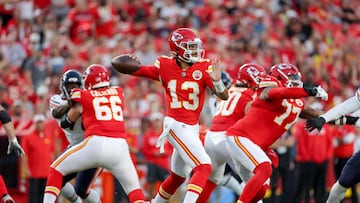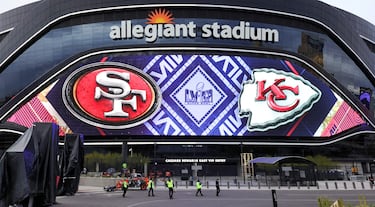Why do the Kansas City Chiefs wear the color red? What is the origin of their logo?
As they go in search of a third straight NFL championship, here’s the background on the Chiefs’ iconic red and white kit.

The Kansas City Chiefs will be one of the main attractions on the opening night of the 2024 NFL season. The reigning Super Bowl champions take on the Baltimore Ravens on Thursday evening as they begin their hunt for a historic third straight championship.
Even before their recent spell of dominance the Chiefs were one the league’s best-known teams in NFL. The franchise even played a key role in the merger between the NFL and the AFL that created the league that is watched all around the world today.
Perhaps one of the most iconic in the entire NFL, the Kansas City Chiefs’ logo has a history all of its own.
Origins of the Kansas City Chiefs
The team, now based in Kansas City, was founded in the 1960s by Lamar Hunt. Originally the team’s name stemmed from its first location in Dallas, Texas.
In 1959 Hunt was encountering difficulties in his efforts to secure a football license in the NFL and he took the decision to establish his very own league, the American Football League (AFL). With Hunt as president, the new league had eight teams when it began to play in the 1960s. The ‘Dallas Texans’ was the name that Hunt selected for that original franchise, in a clear nod to his hometown.
The @Chiefs were founded by businessman Lamar Hunt in 1960 as the Dallas Texans. They swapped their logo from the State of Texas to the now-famous KC arrowhead when they moved to Kansas City, MO three years later. pic.twitter.com/cfDXXbWc9X
— NFL Football Operations (@NFLFootballOps) February 7, 2023
But in1963 the Texans moved to Kansas City, where they became the Chiefs. Despite competition from the NFL the newly-renamed Chiefs became one of the premier football teams in the United States, attracting fans from right across the nation. Chiefs’ owner Hunt was one of key figures behind the merger between the two national football leagues and the Chiefs began play in the expanded NFL in 1970.
History of the Kansas City Chiefs logo
During their early days as the Texans, players for the Chiefs wore a completely different logo on their jerseys. The original symbol of the team was a running gunslinger with a wide-brimmed hat, a pigskin football in one hand, and a gun in another. The gunslinger, wearing cowboy boots and a shirt that read ‘Texans’, was super-imposed on a map of the state of Texas.
When the team became the Chiefs in 1963 ownership realised that a rebranding was needing and the badge was replaced with an image of a Native American. However some aspects of the original badge remained. The figure on the logo was still pictured in front of a map and holds a pigskin football in one hand. A small red axe was introduced in place of the gun.
The logo continued to use the colours red and white, with accents of gold. However the map of Texas was replaced by one that depicted the states of Nebraska, Oklahoma, Missouri, Arkansas, and Iowa.
Who designed the Chiefs logo?
In a stark contrast to those intricate early logos, today’s offering is much more minimalist. The Chiefs’ logo simple features the letters ‘KC’ enclosed in an arrowhead shape. That is now the only reference to the Native American identity taken on previously.

It has been claimed that Lamar Hunt, the team’s founder, was responsible to the new logo, which was first used in 1970. Hunt supposedly sketched the first design for the now-iconic logo on a napkin, taking inspiration from the ‘SF’ on the helmets of the San Francisco 49ers.
Why do the Chiefs wear red and white?
Today, the Chiefs uniform is one of the most recognisable in the NFL. While the logo has gone through an evolution, the base colours of red and gold have not.
Related stories
It is thought that Hunt had initially wanted his Texans team to wear blue and orange, but that was deemed too similar to the blue and scarlet used by the Houston Oilers. As such Hunt opted for the red and gold instead, a decision that remain the team’s colours to this day.
In 2007 the Chiefs made one more significant alteration to their uniform, adding an AFL patch on the left chest to honour the work of Lamar Hunt in creating the franchise and developing the league. From 2008 onwards the patch became a permanent fixture of the Chiefs’ home and away jerseys going forward, a fitting tribute to the team’s founder.


Complete your personal details to comment